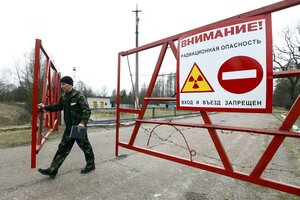Chernobyl will be unhabitable for at least 3,000 years, say nuclear experts
Three decades after the world's worst nuclear disaster, the city of Pripyat, Ukraine, is still thousands of years away from resettlement.

An employee opens the gate at the checkpoint "Maidan" in the 30 km (19 miles) exclusion zone around the Chernobyl nuclear reactor near the abandoned village of Babchin, Belarus, March 11, 2016.
Vasily Fedosenko/Reuters
Tuesday will mark 30 years since the world’s worst nuclear accident at the Chernobyl Nuclear Power Station in Pripyat, Ukraine.
“The Chernobyl disaster caused irreversible damage to the environment that will last for thousands of years,” says Greenpeace in their 2016 study of the accident. “Never in human history has such a large quantity of long-lived radioisotopes been released into the environment by a single event.”
Although three decades have passed since the accident, the town of Pripyat is no closer to being repopulated. The immediate area around Chernobyl will have to remain empty for at least 3,000 years because of dangerously high contamination levels, proof, say some opponents, of nuclear energy’s long-term dangers.
“Despite proponents’ claims that it is safe, the history of nuclear energy is marked by a number of disasters and near disasters,” explains the organization Physicians for Social Responsibility. “The 1986 Chernobyl disaster in Ukraine is one of the most frightening examples of the potentially catastrophic consequences of a nuclear accident. An estimated 220,000 people were displaced from their homes, and the radioactive fallout from the accident made 4,440 square kilometers of agricultural land and 6,820 square kilometers of forests in Belarus and Ukraine unusable.”
A power surge during a reactor test led to an explosion of Unit 4 on April 26, 1986 and subsequent fires throughout the plant. Approximately 150,000 square kilometers of land between Belarus, Ukraine and Russia (an area larger than the state of New York) was contaminated so severely that 8 million people suffered serious land use restrictions or relocation and 5 million people still live in zones considered radioactive in 2016.
“We knew, with certainty, with arrogant certainty, that we were in control of the power we were playing with. We could make the forces of nature bend to our will. There was nothing we could not do,” Sergiy Parashyn, an engineer at the plant from 1977 to the day of the disaster, tells the Kansas City Star. “This was the day, of course, when we learned we were wrong.”
But nuclear experts currently working to clean up the site say a return date of 3,000 years is optimistic.
"Because some of the isotopes released during a nuclear accident remain radioactive for tens of thousands of years, cleanup is the work not just of the first responders but also of their descendants and their descendants' descendants," writes Time's Eben Harrell and James Marson. "Asked when the reactor site would again become inhabitable, Ihor Gramotkin, director of the Chernobyl power plant, replies 'At least 20,000 years.'"
Despite the 3,000 – or 20,000 – year warning, some locals have decided to repopulate the area their relatives called home.
“My husband had wanted to come back to his homeland all his life. He came back when it was all closed here, when it was prohibited to come here. He crossed through the barbed wire,” Oleksandra Lozbin, one of the estimated 160 people to return to the zone, tells Reuters. Lozbin and her husband returned to their home seven kilometers away from Chernobyl in 2010. “We decided to save the history of Chernobyl. We hope that people will come back here and will live here, and their children and grandchildren will see what life was like here…”
Not only are Lozbin and her neighbors returning home to the disaster site, but wildlife is also reemerging in the desolate area.
A recent new study of the 1,000 square-mile area surrounding the Chernobyl nuclear plant found that animals are living normally in the area despite the high radiation levels.
“When humans are removed, nature flourishes – even in the wake of the world’s worst nuclear accident,” Jim Smith, an environmental scientist at the University of Portsmouth in England, tells The Christian Science Monitor. “It’s very likely that wildlife numbers at Chernobyl are now much higher than they were before the accident.”

